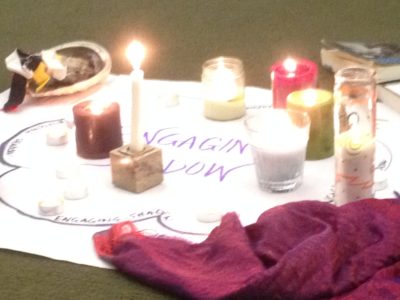
Last week at the first session of our series, The Inner and Outer of Evolutionary Leadership: Engaging Shadow, Kinde Nebeker offered a “To Try.” It was homework. It was practice. It was a call to attentiveness.
- Feel it.
- Be willing to explore if there is a kernel of truth in it.
- Follow clues, and feel it again, now for difference.
This is solid advice and practice that I’ve taken to heart myself in the last four days. And even though it is practice that feels familiar, there is something additionally powerful in being reminded. What’s happening for me is what Kinde and I invoked in the group — “you will get what you are willing to look for.”
It’s feeling like a lot. Mine is a kind of terror, mentally and emotionally, about a suppressed thought that I generally have preferred, unconsciously, to keep suppressed. That thought has even more power when connected to a few life experiences that were painful. It’s easy to see how the movie playing inside of me can become so rigid, fearful, and punishing.
As Kinde and I shared with others in the session, when working with shadow, there are some closely related landscapes. Trauma is one. Conflict is another (or at least a gateway in to shadow). Even sabotage. And, there are many important and related ways of working with these. Therapy and counseling come to mind. The Work of Byron Katie is another, that is so good an interrupting the movie.
Feel it — this is very much about being willing to stay, unprocessed as Kinde reminds me, in the feeling. The ickiness. The painfulness. The fearfulness. The immediate impulse to deny. My partner Teresa Posakony teaches that these are all responses of contraction, neurally entrained liked carved canyons in our minds and psyches, that activate our reptilian brains — the ones that know mostly flight or fight. She says, “the part of our brain that we need for such experiences is mostly offline because we default to contraction.” Stay in the feeling. The stickiness. The ache in the back of the neck. The ever so slight turning of the head away, as if we can look away, and avoid, making it disappear. We all do this — let’s not kid ourselves. This is a call for awareness and interruption, not perfection and denial.
Explore the kernel of truth — of the “it.” That nasty thought or feeling that we are trying to stay clear of. I love what my friend Caitlin Frost does with these kernels in her Work of Byron Katie. “It may be true, which can be freeing to realize. Just because it is true some of the time doesn’t make it true all of the time.” I find that the sharing of these embarrassing kernels can become such a humanizing process together. We get to recognize a widely shared experience, shifting it from a mythology of extremely isolated.
Follow clues — I love the way Kinde speaks of this as clues to liberation. It’s not court room testimony clues that we are looking for. It’s not proof and absolutism. Nor is it a mind game to convince us that everything is OK. It’s clues that unlock the hold that a blind spot, or a shadow-infused stress, or a trauma-impacted rigidity can have on us. The surprising (and yet not) thing is how many clues there typically are. It turns out the world is not colluding against us.
I’m grateful for this simple “To Try.” I’m excited to move our attention in the next session from this awareness of shadow in self to exploring how shadow becomes part of groups. And I continue to hope for an evolution of who we are as humans, and how we are together, in the needs of communities, large and small, that we claim as dear.
